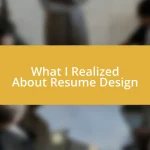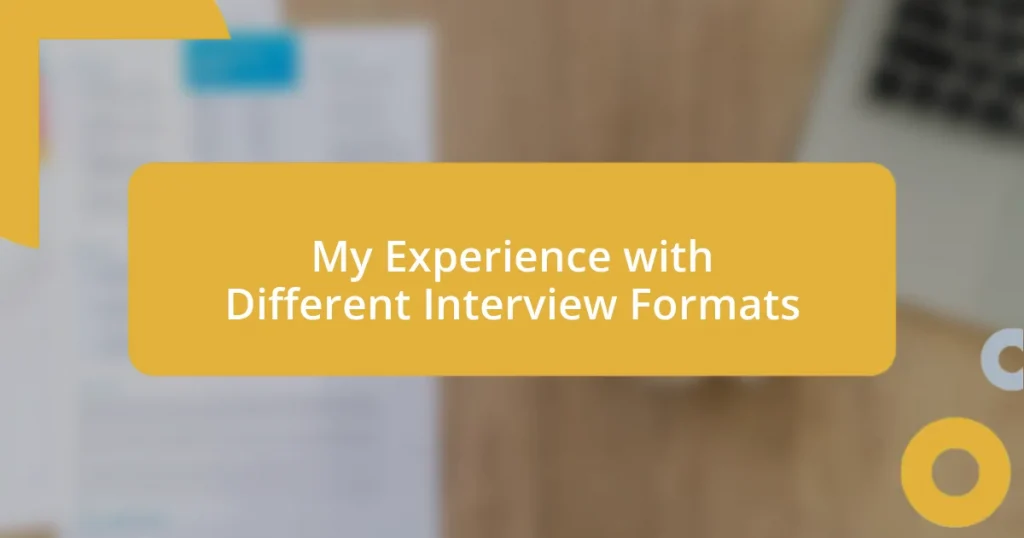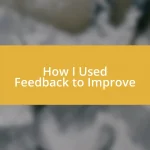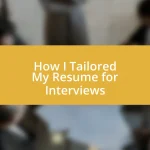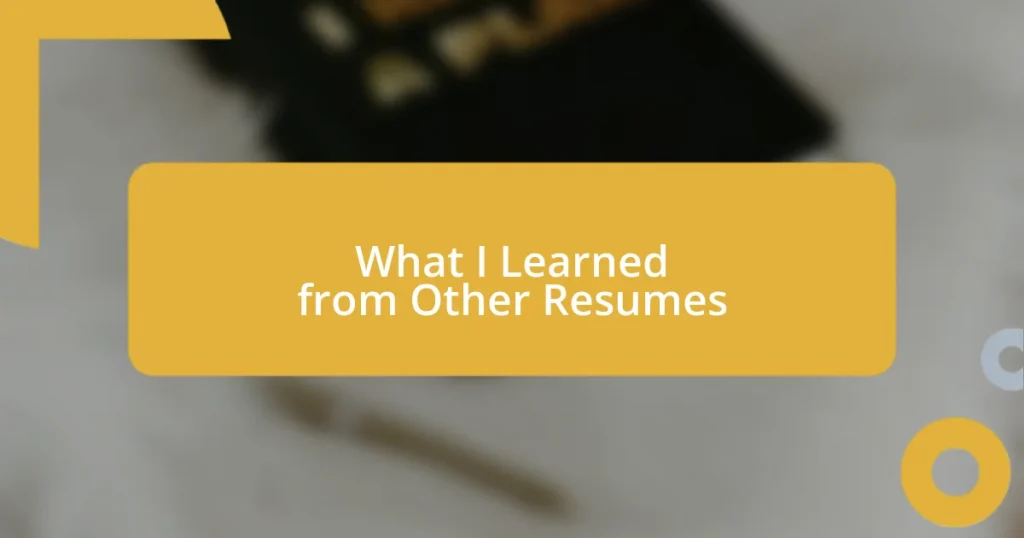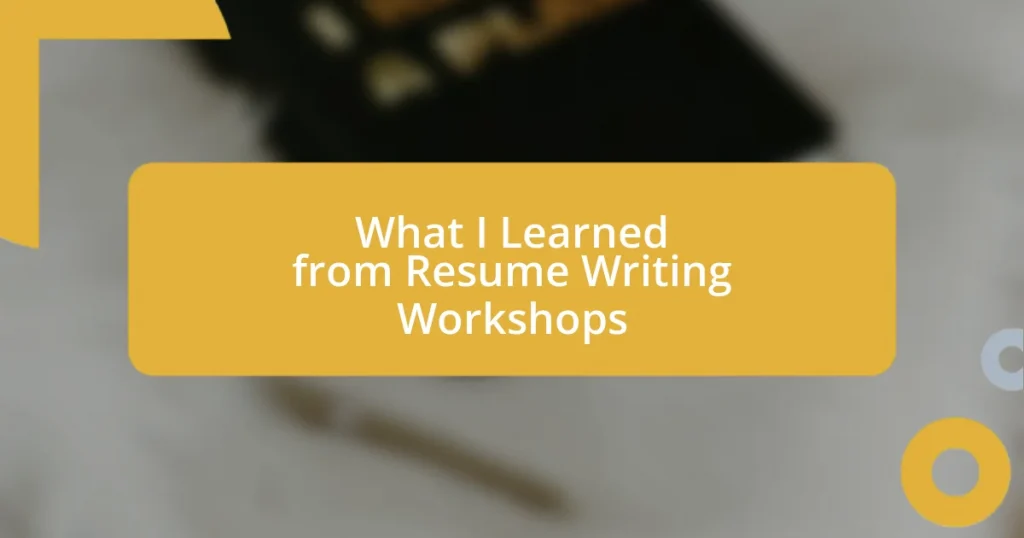Key takeaways:
- Interview preparation is about more than just content; it involves self-reflection and adapting delivery to engage interviewers effectively.
- Understanding the dynamics of various interview formats (one-on-one, panel, behavioral, video) is crucial for improving adaptability and building confidence.
- Authenticity and emotional awareness during interviews can significantly impact outcomes, emphasizing the importance of genuine connections with interviewers.

My interview preparation journey
Preparing for interviews has always felt like stepping onto a stage for me. I remember the knot in my stomach as I practiced answering typical questions in front of my mirror, hoping I’d sound confident and composed. Isn’t it fascinating how your own reflection can serve as both a judge and a coach in those moments?
One particular experience stands out: I decided to film myself while answering questions. Watching the playback was eye-opening; I noticed not only my verbal mistakes but also my body language. Can you believe how much we might miss when we don’t see ourselves through someone else’s eyes? That moment made me realize that preparation isn’t just about the content, but about delivering it in a way that resonates with the interviewer.
As I navigated the various interview formats—those daunting panel interviews, casual coffee chats, or the dreaded video calls—I learned to adapt quickly. Each format posed unique challenges, but I grew more resilient with every opportunity. Have you ever found yourself stumbling through a format you weren’t prepared for? I certainly have! But by embracing those challenges, I discovered that preparation goes beyond rehearsed answers—it’s about cultivating a mindset ready to face the unexpected.

Understanding interview formats
Understanding interview formats can feel overwhelming, but each type brings its own flavor of interaction. I recall walking into my first panel interview, where several interviewers scrutinized me at once; it felt like being under a spotlight with eyes everywhere. I remember the palpable tension in the room, which made me acutely aware of how vital it is to connect with each member.
- One-on-One Interviews: Intimate settings allowing for deeper conversation; great for establishing rapport.
- Panel Interviews: A group of interviewers assesses your responses, testing not only your answers but also your ability to manage pressure.
- Behavioral Interviews: Focus on past experiences to predict future behavior; this requires you to share detailed anecdotes.
- Case Interviews: Common in consulting, these involve problem-solving exercises to evaluate analytical thinking.
- Video Interviews: Growing in popularity, these require adaptation to the camera and often involve technical challenges and maintaining eye contact.
These formats shaped my journey, pushing me to refine not just my answers, but also my approach and adaptability. I remember feeling like an actor adjusting to multiple roles, each requiring a slightly different performance style. It’s in mastering these elements that I found my confidence growing with every interview.

Benefits of the traditional interview
The traditional interview format offers a level of personal interaction that is often hard to replicate in other settings. I cherish the moments when I sat face-to-face with interviewers, where a firm handshake and warm smile set the tone. It’s remarkable how the subtle cues in body language and tone can convey genuine interest and rapport, often making me feel more at ease.
Another appealing aspect of this format is the opportunity for immediate feedback and dialogue. When I recall my experiences, I remember Jonathan, the hiring manager who asked probing questions that led to an enriching discussion. His follow-up questions not only validated my responses, but they also encouraged me to elaborate and showcase my passion. This direct interaction fosters a more dynamic exchange, making it easier to clarify doubts or expand on key points that might enhance my candidacy.
Lastly, traditional interviews provide a structured environment that can ease anxiety. I found that having a set location, time, and format gave me a sense of control over what could often feel like an overwhelming experience. Honestly, when I entered a familiar office with a clear agenda, it helped me focus on articulating my experiences rather than worrying about any unexpected technical issues that might arise in other formats.
| Benefit | Description |
|---|---|
| Personal Interaction | Facilitates connection through body language and facial expressions. |
| Immediate Feedback | Encourages dynamic conversations that allow for deeper insight into responses. |
| Structured Environment | Offers predictability, aiding in reducing anxiety and allowing for focused conversations. |

Navigating behavioral interview types
Navigating behavioral interview types can often feel like peeling back layers of an onion, revealing insights about not just the job but about myself as well. I’ve found that these interviews really dig into my past experiences, requiring me to reflect deeply on my actions and decisions. I remember one particular interview question: “Can you describe a time when you faced a significant challenge at work?” As I shared my story about overcoming a tough project deadline, I could feel the interviewer’s engagement, and it became a pivotal moment.
I’ve learned that the key to excelling in behavioral interviews lies in structuring my anecdotes effectively. The STAR method—Situation, Task, Action, Result—became my secret weapon. Each time I prepared to answer a question, I’d rehearse my responses using this format, ensuring clarity and impact. Well, there was one time when I was asked how I’d handled conflict in a team project. Instead of just stating the outcome, I dove into the context and my specific actions, which helped to paint a vivid picture and demonstrated my problem-solving skills.
Moreover, I can’t stress enough how crucial it is to stay calm and collected during these interviews. I recall sitting in front of an interviewer, feeling that familiar wave of nerves wash over me. But then I remembered to breathe and refocus on the question, transforming that nervous energy into a drive for clarity and authenticity. The ability to relate my past experiences in a concise and meaningful way not only showcases my qualifications but also my growth, leaving a lasting impression. Wouldn’t you agree that our stories can often be our strongest assets?

Mastering the panel interview process
Mastering the panel interview process can be a game-changer, especially when I think back to my own experiences. I remember walking into a room with multiple interviewers, each armed with different perspectives and questions, creating a unique pressure. Instead of feeling overwhelmed, I focused on making eye contact and engaging each panelist, finding rhythms in their discussions that made the experience more engaging and less daunting. Has that ever happened to you?
One strategy that worked wonders for me was to prepare not just for individual questions but also to understand the dynamics of a group. For example, during a panel interview for a marketing role, I noticed how one interviewer seemed particularly interested in team collaboration. Instead of just talking about my own achievements, I highlighted how I contributed to projects by fostering open communication within my teams. Being able to connect my answers to the interests of different panelists helped me feel more like a collaborative peer rather than a candidate on trial.
In those moments of intense scrutiny, I found that pausing before answering could be incredibly powerful. Reflecting for just a second or two allowed me to gauge the reactions of the interviewers and tailor my responses accordingly. It’s a bit of a dance, isn’t it? Balancing what I want to say with what they need to hear. That approach not only eased my nerves but also projected confidence, displaying that I could handle not just the questions but the dynamic nature of the interview itself.

Tips for virtual interviews
Preparing for a virtual interview can be a different beast altogether, and I’ve learned to adapt in several ways. First, I always check my technology beforehand. In one memorable interview, I frantically tried to troubleshoot my camera while the interviewer waited. Thankfully, I managed to resolve it, but the moment left me flustered. Now, I remind myself that a quick test run can make all the difference, ensuring technical hiccups don’t distract from the conversation.
Another tip that has served me well is to create a distraction-free environment. I once had an interview interrupted by a neighbor’s loud music, which threw me off my game. Since then, I’ve set up my space with minimal distractions and invested in a good set of headphones. This also helps me tune into the interviewer better, creating a more engaging interaction. Have you ever thought about how your surroundings can impact your focus?
Additionally, lighting and framing are crucial in a virtual setting. I remember my first virtual interview where I was half in shadow, and it felt like I was hiding from the interviewer. Now, I make sure I’m well-lit and centered on-screen, making it easier for the interviewer to see my expressions and engage with me directly. This attention to detail speaks volumes and can elevate how I come across as a candidate.

Reflecting on my interview outcomes
Reflecting on my interview outcomes has been quite the journey. After each interview, I often find myself analyzing not just what I said, but how I felt during the process. For instance, I remember walking away from one particular interview feeling confident and energized, only to later receive a rejection email. It made me question what went wrong. Was it my energy that didn’t connect with the interviewer’s expectations, or was it something deeper?
In another instance, I completely bombed an interview when I felt overly nervous, struggling with my words. I went home thinking I could have prepared differently, especially around the company culture. Why didn’t I emphasize my adaptability that day? The lesson learned was substantial; my emotional state can impact not only my performance but how I perceive the outcome. It reminded me that not every conversation leads to a successful outcome, but each experience offers valuable insights.
I’ve noticed a pattern in my reflections: the interviews where I felt genuinely myself often led to more encouraging outcomes. It’s fascinating how authenticity creates a connection. When I engage sincerely and share my true experiences, I find I resonate more deeply with interviewers. What are your thoughts on authenticity during interviews? Have you seen it make a difference? Overall, reflecting on these experiences has taught me that each interview is less about the result and more about the lessons they bring.



